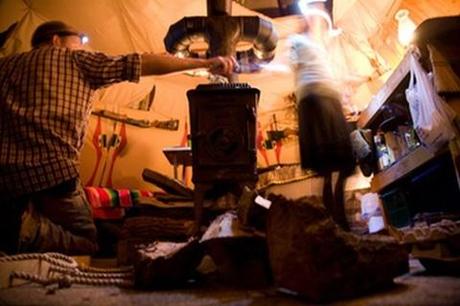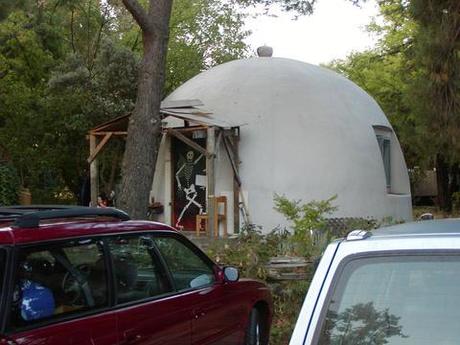
Photo by: Nobu Tanaka
Living in a Tipi
Brett Butler grew up with Paul Goble’s paintings of tipis in his bedroom, which Brett’s mother believes may have subliminally encouraged him to live in one. Besides living in a 256 square foot tipi, Brett lessens his impact in just about every way – he rides a motorcycle instead of driving a car, eats organic and local as much as possible, uses a composting toilet, recycles, dumpster dives, and even scrapes up fresh road-kill (yes, road-kill) at times for food. He also runs an educational company called Field Trips Delivered, which brings environmental field trips to educators, students, and camp directors versus having them plan and embark on an expensive trip themselves.
Why did you decide to live in an alternative home?
After attending college for a few years [at Appalachian State in North Carolina], I was sharing a house and paying way too much for rent and really having an unhappy time working a lot to pay bills and all that jazz. I had lived in a tent for a month between living in the dorms and moving into that house, so I decided that I would take the plunge, and move back to the woods and live outside and see how it went.
I bought the cover and liner and had a friend of a friend cut some poles for me, and one day a friend and myself cleared a place to set the tipi up on a farm where I was working, and with permission from the farm owner, I set up and moved out of the house and into the tipi. I haven’t looked back since then.
Why/how did you choose a tipi? How did you build it?
A tipi is an extremely simple structure. Canvas and wood, and a few pieces of rope, and you’ve got yourself a home. And not just a little home; it’s big and spacious and warm in the winter, cool in the summer, and comfortable pretty much all year round.
The cover of the tipi is made from a special canvas called Sunforger, which is used to make sailboat sails since it is mold and mildew RESISTANT, and UV light-degredation resistant. I say resistant in bold because it is starting to mildew on the outside and looks a bit rough, but it looks lived-in. [Appropriate,] since “tipi” is actually two Lakota Sioux words, ti pi, meaning “place lived in.”
The actual set up process is quick once you’ve got the hang of it, and I can set up a tipi in about 6 minutes now, and have it staked down in another 5.
What’s the hardest part about living in a tipi?
Everything is just DIFFERENT. I don’t flick a light switch to turn my lights on, I strike a match and light my beeswax candles and oil lamps. I don’t turn the thermostat up or down, I put more wood in the woodstove to heat my place up, or roll up the sides to get a little breeze flowing to cool it down in the summer.
To get water, I fill up 5-gallon water jugs either at a spring or from the faucet at my host’s home and use a small hand pump to get it from the jug to pots, pans, water bottles or my teakettle. I guess I would say the thing I miss the most is running water.
---------------------------------
Life in a Geodesic Dome
Jake Weller is a student at Juniata College in central Pennsylvania who decided to live in a geodesic dome for the 2009-2010 school year when he figured that he could live in his own structure more cheaply than the other options.

A geodesic home, part of the Baggins End community, on the University of Davis campus. Photo via Flickr/basykes
What is a geodesic dome and how did you choose to live in one of these versus another type of alternative home?
A geodesic dome (GD) is a geometrical structure based on a mathematical formula developed by R. Buckminster Fuller. It is a relationship between the side lengths and angles of struts which follow a set pattern.

This story originally appeared on Matador Network, a Dwell partner site. Abbie Mood is a Denver-based writer for Matador Network. Read all her posts here.
It is one of the strongest and most efficient structures possible, in terms of materials. And the only one (that I know of) where the strength of the structure increases with size.
I chose a GD for several reasons, including: structural strength, the possibility of using recycled and recyclable materials, aesthetic preference, portability, and ease of fabrication.
What is the hardest/worst part about living in the geodesic dome? The best part?
The most difficult part was deciding on a cover design, especially considering that the structure had to be portable.
The best part has been the experience of actually doing it, and seeing how feasible such a project would be. I have really enjoyed it so far.
